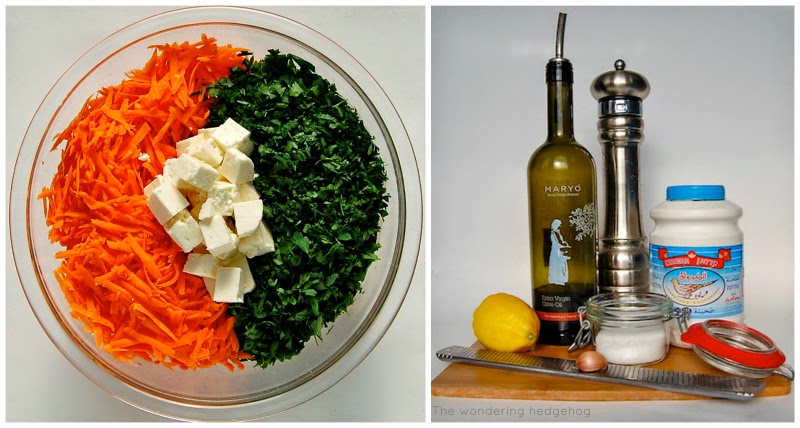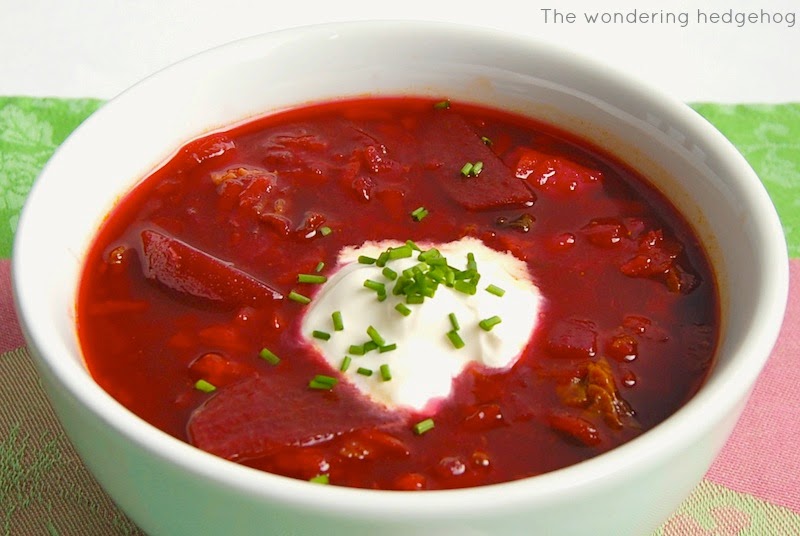~ Homer J. Simpson, The Simpsons: Lisa the Vegetarian
As an opportunistic omnivore, I eat almost everything. Joyfully, most foods turn out to be tasty, if not downright delicious. The list of foods I have disliked and would prefer to avoid in the future is mercifully short - sea cucumbers (childhood phobia plus a texture bias), boiled onions and boiled carrots. That last one seems particularly sad - the soggy texture, the washed-out color, the watered-down flavor. Bright orange, sweet and crunchy are the defining characteristics of carrots; it seems unjust to deprive them of their identity.
Thankfully, this salad both highlights and takes advantage of the carrot's natural talents. Bright in both color and flavor, it brings together the sweetness of carrots, the grassy sharpness of parsley and the briny tang of feta. The result is both good and good for you, full of vitamins and antioxidants, and studded with luscious cheese.
Serve with olives and some charcuterie as an appetizer, as a light side with meat or fish (perhaps omitting the feta), or by itself as a refreshing lunch. However it is presented, everybody goes for second helpings.
This salad is indebted1 to Deb Perelman's carrot salad with tahini and crisped chickpeas. After trying Deb's recipe, I found that I absolutely loved the zesty tahini dressing and the way it contrasted with the carrots. The roasted chickpeas and pistachios were not not my favorite elements - the carrots had enough texture on their own, and I found myself wandering in a different direction, a salty softness in place of spicy crunch.
Carrot-feta salad with tahini dressing
Serves 4-6
Do make more than you need. This dish is seriously addictive, and keeps very well in the refrigerator for several days.
Salad
- 1.5 pounds carrots (4-7, depending on size)
- 1 large bunch of parsley (2-3 cups loosely packed leaves)
- ½ pound feta cheese
- 2-3 Tablespoons fresh lemon juice (1 medium lemon)
- 2 Tablespoons tahini
- 2 Tablespoons olive oil
- 1-2 Tablespoons water (bottled or boiled)
- 1 clove garlic
- 1 teaspoon kosher salt
- freshly ground black pepper
Peel and grate the carrots on the the large holes of the grater. A food processor shreds the carrots too finely to maintain the crunch; a little additional effort here makes a big difference.
Wash the parsley, shake off as much water as possible (or use a salad spinner) and remove the leaves from the stems. Roughly chop the leaves - they should be small enough to blend easily with the carrots but large enough to still have some texture.
Cube the feta cheese. If you are feeling particular, 1cm (¼ inch) cubes.
Prepare the dressing directly in a large bowl. Peel and finely mince the garlic. Add olive oil, salt and pepper.
Stir the tahini well before using. Tahini will separate over time, with solids sinking to the bottom and a layer of sesame oil forming on the top. Use a clean, dry utensil - tahini keeps practically forever, as long as it is not contaminated.
Roll the lemon on the counter before cutting and juicing to break the membranes and release more juice. If using a lemon directly from the refrigerator, microwave for 30 seconds before cutting. Juice the lemon into the the bowl (use a strainer or your fingers to catch the pips) and mix the dressing. Tahini will emulsify the dressing; add 1-2 Tablespoons of water to thin it out - it should pour easily.
Add the grated carrots, chopped parsley and cubed feta to the dressing; mix to combine. Taste and adjust the seasonings if necessary.
Serve sprinkled with toasted sesame seeds for an added crunch.
A quick ingredient note - the olive oil used in the dressing was a lovely gift from a thoughtful friend. The oil came from friends of the friend - a Greek couple who recently started a small business exporting artisanal olive oil (from a monastery, no less!). This oil is absolutely wonderful. It has a bright, grassy flavor without being bitter or overpowering. It is robust enough to stand up to sharp flavors like garlic and feta, and mild enough to dress delicate greens. I have been lucky enough to taste olive oils from some amazing producers all over the Mediterranean, and this is easily in my top three. I really recommend visiting Maryó's webstite and purchasing a bottle or two2.
1Ha! A terrible, unintentional pun.










